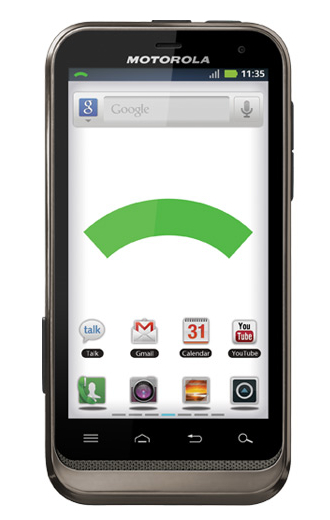Review: Motorola Defy XT on Republic Wireless Unlimited Everything for $19 a Month
Value? Definitely. Is It For You?

|
BY JOE PROCOPIO •
@jproco •
1.11.13
| |||||||||||||||||
Entrepreneurs and Investors:
Log in to ExitEvent to get a whole lot more out of it. There are hundreds of you back here.
Log in to ExitEvent to get a whole lot more out of it. There are hundreds of you back here.
Filed Under: NEWS: Technology
 There's a lot to like about what Durham's Republic Wireless is trying to do in the increasingly expensive world of mobile phone plans. On the surface, their $19 all-you-can-eat (plus $249 for a handset and a one-time $10 setup fee), no contract, no termination fee plan is an astoundingly unfair shot against the big wireless providers. Not everyone needs an iPhone 5 or a Galaxy S III.
There's a lot to like about what Durham's Republic Wireless is trying to do in the increasingly expensive world of mobile phone plans. On the surface, their $19 all-you-can-eat (plus $249 for a handset and a one-time $10 setup fee), no contract, no termination fee plan is an astoundingly unfair shot against the big wireless providers. Not everyone needs an iPhone 5 or a Galaxy S III. And while there are no catches per se, there are definitely some things about a plan this inexpensive that you'll want to know and you'll need to get used to.
Keep in mind: It's $19 a month.
Update (2/20/13): Republic has now rolled out a plan that's $99 for the phone and unlimited everything for $29 a month.
You also get 30 days to make sure that this is the phone and service for you. Fair enough.
I switched over from my fancy-shmancy Android 4G smartphone to the Republic Wireless Motorola Defy XT for a week. Here's what I found.
Your Calls Will Go Over WiFi When Available
This is part of what makes the unlimited plan so inexpensive. Calls and SMS (there is no MMS) are configured to go over WiFi when it's available. When not on WiFi, the phone uses Sprint's 3G network.
But be aware that if you're on a WiFi call and you leave WiFi range, the call doesn't hop over. That's not possible. What happens is the call is dropped and the phone will automatically redial over 3G.
There are maybe a couple times a month when I'm in my home or office, initiate a call, and then leave. With a little planning ("let me call you right back"), this can be worked around. And note that if you're on a 3G call and you enter WiFi, the phone stays with the 3G and doesn't attempt to switch over to WiFi.
The Motorola Defy XT Runs Android 2.3 (Gingerbread)
This is not as bad as I thought it'd be, Just like every other Android phone I've tested, I was nearly mirrored in about five minutes. However, my apps, app preferences, and bookmarks did not gracefully fall from the cloud, requiring me to download the apps all over again (I didn't bother with the bookmarks). I don't know if this is because that wasn't invented for 2.3 or I just couldn't figure out how to do it, but it was just an extra 20 minutes at setup.
Otherwise, I wasn't roadblocked going back in time to 2.3. All my apps worked like they do today, with no major issues. I'm sure this will present itself at some point, but so far so good.
While the Android OS got some major upgrades between 2.3 and 4.0 (I'll leave off talking about Jellybean because that just wouldn't be fair), mostly what I missed was speed, ease, and polish. If you've never had a smartphone, you're not going to notice the drawbacks of 2.3. If you have, you might get frustrated, but not stranded.
The Defy XT is Not a Performance Handset
Just like with the OS, if you've never had a smartphone, you may not notice some of the dated features on the Defy XT. I won't get too deeply into specs, because this is a budget handset by design, not a performance handset, but just about every aspect of the phone is average.
A couple nice features about the Defy XT is that it's small -- it's a pet peeve of mine that there's this unnecessary phablet niche being carved out with screens as big as 5+ inches, making most phones difficult to use with one hand. The Defy XT is about the size of the iPhone 4, it's light, and it's comfortable to hold and use.
It's also meant for abuse, so to speak. It's dustproof, water-resistant, scratch-resistant, and it has rubber covers for the USB port and headphone jack. It's also got a rubberized back cover for less drops. Love that.
Probably a good choice for the kids.
It's a 3G Network
Oddly enough, I'm not a huge media consumer away from WiFi, so this didn't bother me too much. Facebook and other apps run a little slower, but not dead slow.
The Test Drive
Once I had the phone configured to match my day-to-day, it really didn't take me that long to get into the swing of the Defy XT. For a handset of it's type, it really is nice-looking and easy to use.
I never really thought about the switch back and forth between Wi-Fi and 3G. In fact, when I reviewed my calls over the week, I never moved out of range on about a dozen WiFi calls. However, the call quality on the WiFi calls was tolerable, but definitely noticeable. Republic is a spinoff of Bandwidth.com, also from Durham, so I had high expectations for the WiFi call quality. The closer I moved to my wireless source, the better the call. I even got through a couple work calls on it.
When not on WiFi, the calls were clear, almost as clear as my 4G Verizon phone. In my car setup via Bluetooth, I didn't notice any difference at all.
Apps and notifications both worked really well. I never missed an email, social ping, or alert, and got them at the same pace and ease that I get with my standard phone. Maps and navigation also worked fine, if a little slow to initially find my location.
The Defy XT comes with a 2GB microSD which you can upgrade. It also comes with a removable battery. The battery life is going to be determined by WiFi vs. 3G usage. On 3G with moderate use, I was getting about 8 hours. On WiFi, I could easily go a day and overnight.
Now, I mentioned that most of the features on the Defy XT were right about at average. The keyboard, which I am a HUGE stickler about, was quite above-average. I was actually surprised at how few times I mistyped a word. Other input however, touch, swipe, etc, was not as elegant. Not terrible, just not as elegant.
The video camera, at 640x480, is probably the only aspect I'd qualify as below average, harkening back as it does to older phones. And speaking of, we're at the point now where mobile phones have replaced point-and-shoot digitals. The Defy XT will not replace your budget Elph.
Finally, media is worthy with audio and fair with video.
All in all, if it came down to it, I could get by on the Defy XT and the $19 a month plan. It is in no way comparable to my Android 4G or my wife's iPhone but...
Here's The Kicker
Let's do a little quick math. Let's say the wife and I had to start all over again, and let's say we chose not performance handsets, but middle-of-the-road handsets from Verizon on the share everything plan. For the phones ($100 each) the line charges ($40/mo. each) and 4GB of shared data ($70/mo.), we're talking about $3,800 over two years.
I know. You never realize it until you add it all up, right?
With the Republic Wireless plan, the Defy XT phones ($249 +$10 setup fee each) and plan ($19/mo. each), come to $1430 over two years.
There are taxes and FCC garbage on both sides, but this is apples to apples.
So is the Defy XT on the Republic Wireless plan a value? Assuredly. Is it the phone for you? Well, that depends. Are those workarounds worth $2,370 over two years?
That's for you to answer.
Companies We Mentioned In This Post
|
|
You Might Also Be Interested In
 How to Judge a Startup Competition
How to Judge a Startup CompetitionI'm not usually the kind of guy you find judging a startup competition. In the jungle-like ecosystem of entrepreneurism, I'm the worker bee, or maybe the howler monkey, but definitely the guy who likes to work on cool new stuff and talk about that stuff.
 The Top Three Things Startups Should Do For Their Startup Community
The Top Three Things Startups Should Do For Their Startup CommunityBack at the end of January, I wrote an article called The Top Four Things Startups Want From Their Startup Community, based on what I had learned from the 100+ entrepreneurs who attended that month's ExitEvent Startup Social.
 Google Glass is Awesome! Let's Ban It!
Google Glass is Awesome! Let's Ban It!I don't like to talk about politics. I like to talk about startups. That being said, when government sticks their hands into the rich dough of innovation, the result is usually a big mess of dough and a complete lack of paper trail on where the money went
 Raleigh-Durham's Next Big Startups
Raleigh-Durham's Next Big StartupsMy opinion column in yesterday's WRAL TechWire begins to answer the question: *If the Series A Crunch is a real thing and if it's going to impact the Triangle, where are the startups who are going to lead us out?*
 First ExitEvent Startup Social Charlotte Uncovers A Thriving Early Scene
First ExitEvent Startup Social Charlotte Uncovers A Thriving Early SceneIt's thrilling to know that if you put the right thing out there, something for entrepreneurs and by entrepreneurs that speaks to entrepreneurs in their language, they'll find it.